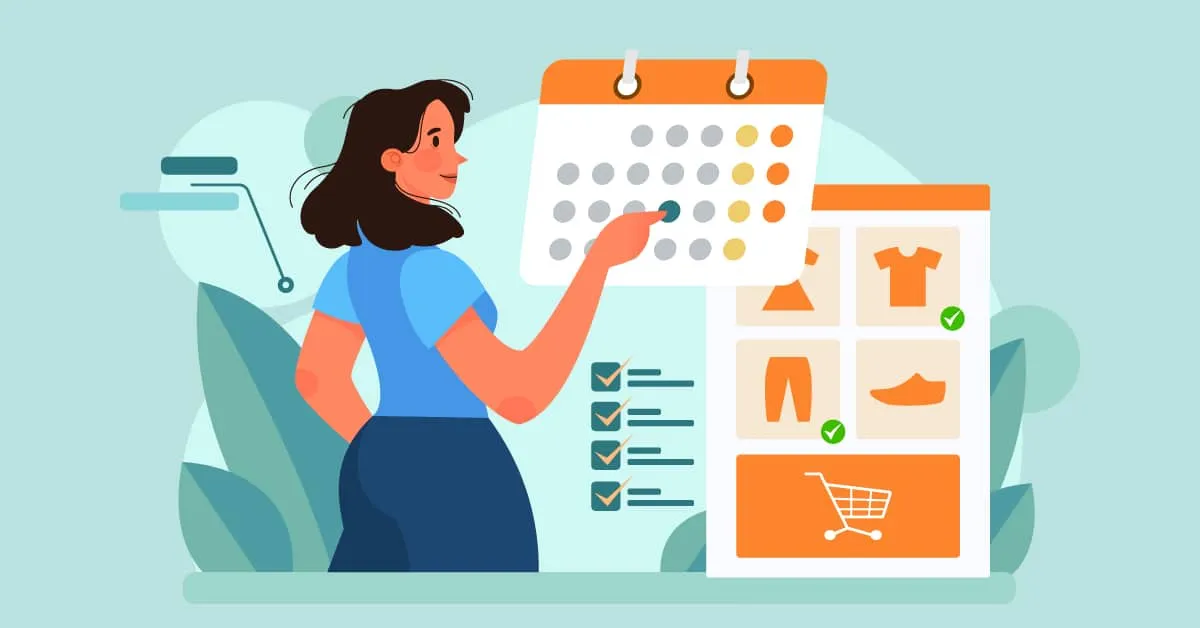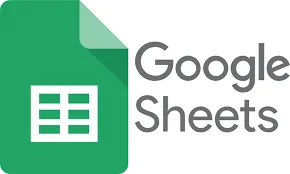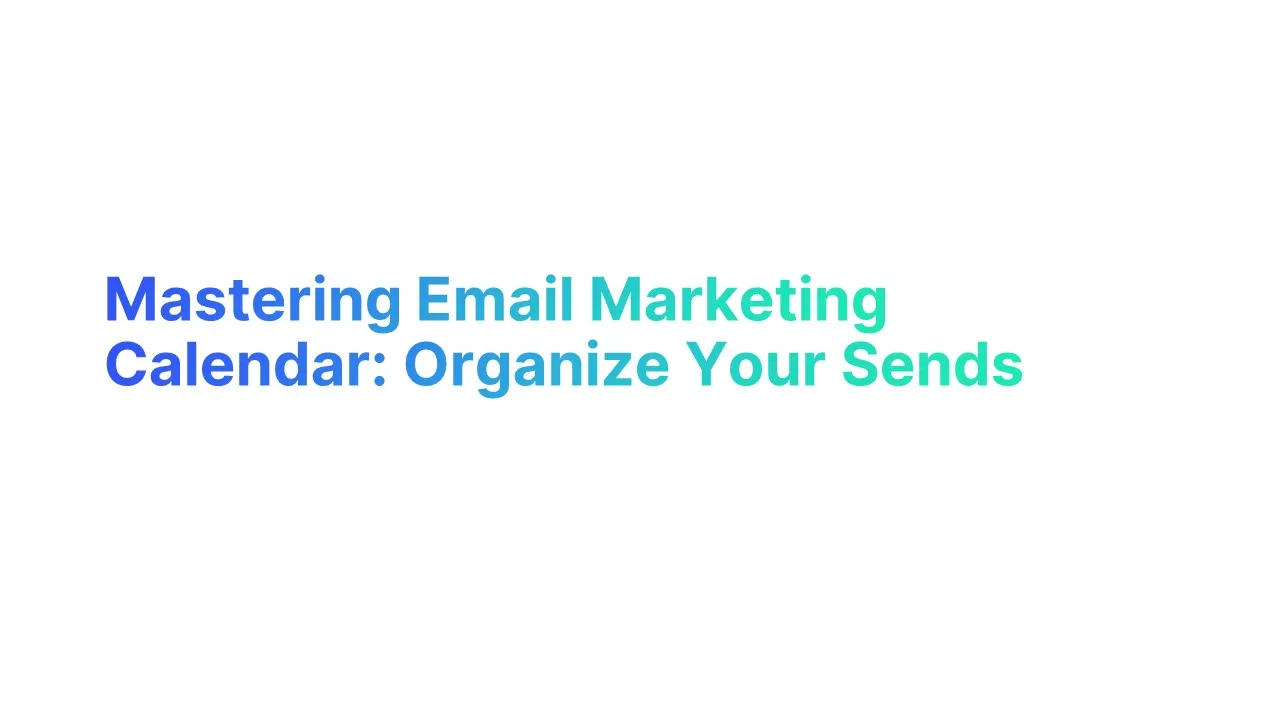Introduction to Email Marketing Calendars

An Email Marketing Calendar is an essential tool for anyone looking to streamline their email marketing strategy. It acts as a roadmap, laying out the timeline and specifics of each email campaign that a business plans to execute.
This calendar encompasses everything from promotional emails tied to specific marketing campaigns to more routine newsletters. By providing a clear calendar view, it enables the marketing team to see at a glance what content is planned, when it is scheduled to be sent, and to which segment of the target audience.
The use of an email marketing calendar template simplifies the process of planning. These templates often come with predefined fields such as subject lines, send dates, targeted messages, and other custom fields relevant to the campaign's goals.
With tools like Google Sheets or specialized email marketing tools, these calendars become collaborative spaces where the entire email marketing team can contribute and stay updated on the marketing efforts' progress.
This level of organization is crucial for timely delivery of campaigns and for aligning email marketing efforts with broader marketing goals and company objectives.
Importance of Calendars in Email Marketing Strategy

Incorporating calendars into your email marketing strategy brings several key advantages:
Strategic Planning: Calendars allow for advanced planning of email campaigns around important dates, special events, and marketing campaigns. This foresight ensures that your marketing messages are relevant and timely, increasing their effectiveness.
Target Audience Engagement: By planning your email content in advance, you can ensure that your messages resonate with your target audience. Whether it's through carefully crafted subject lines, targeted messages for specific segments, or content that addresses the pain points of your audience, a calendar helps in delivering the right message at the right time.
Consistency and Cohesion: A calendar ensures that your email campaigns are consistent and cohesive, contributing to a stronger content marketing strategy. Whether it's promotional emails, social media posts, or other marketing channels, a calendar helps integrate all efforts towards a unified goal.
Performance Tracking and Optimization: With all email campaigns plotted out, it becomes easier to track their performance against the set goals. Click-through rates, unsubscribe rates, and subscriber behavior can all be analyzed to refine future campaigns, making each one more effective than the last.
Efficiency and Collaboration: Email marketing calendars facilitate better project management and team collaboration. By using a shared calendar, possibly within a Google Workspace or another collaborative platform, the entire marketing team, from content creators to strategists, can work in unison. This not only saves time but also ensures that everyone is aligned with the campaign goals and timelines.
Steps to Create an Effective Email Marketing Calendar

Creating an effective email marketing calendar is an essential part of a successful email marketing strategy. It involves careful planning, coordination, and execution to ensure that each email campaign is timely, relevant, and engaging for the target audience.
Here's how you can build a robust email marketing calendar that drives results:
1. Identifying Key Email Marketing Campaigns and Themes
The first step involves pinpointing the key campaigns and themes that will resonate with your target audience. This requires a deep understanding of your audience's needs, preferences, and pain points, as well as the goals you aim to achieve through your email marketing efforts.
Assess Your Marketing Goals: Align email campaigns with overarching business and marketing objectives.
Understand Your Audience: Segment your audience to tailor campaigns more effectively.
Plan Campaigns Around Themes: Identify themes that will interest your audience, such as product launches, educational content, or special offers.
Utilize Email Marketing Templates: Save time and maintain brand consistency by using templates for your emails.
2. Integrating Important Dates and Holidays
Timing is crucial in email marketing. Integrating important dates, holidays, and significant events into your email marketing calendar ensures that your campaigns are relevant and timely.
Highlight Key Dates: Mark important dates, holidays, and industry events on your calendar. Tools like Google Sheets offer a free and easy way to manage this.
Plan Campaigns Around These Dates: Use these dates as anchors for planning your campaigns. For instance, a Mother's Day promotion or a Black Friday sale.
Use a Separate Tab: For clarity, you might use a separate tab in your calendar to list these dates, especially if you're using a digital tool like Google Sheets.
3. Assigning Roles and Responsibilities
For an email marketing calendar to function smoothly, clear roles and responsibilities must be assigned. This ensures that each aspect of an email campaign is executed efficiently, from content creation to the final send-off.
Define Team Roles: Assign specific tasks to team members, such as writing email content, designing the email layout, and managing the send schedule.
Collaborate with Other Teams: Involve other teams as needed, such as the design team for creating landing pages and the content team for crafting compelling subject lines.
Utilize Project Management Tools: Tools like Trello or Asana can help manage tasks and responsibilities, providing a timeline view of upcoming campaigns and deadlines.
Update the Calendar Regularly: Keep the calendar up-to-date with campaign progress, changes in scheduling, and any new campaigns. This ensures everyone on the team, and potentially in other teams, is aligned and informed.
4. Setting Campaign Goals and Objectives

Establishing clear goals and objectives for each email campaign is crucial for measuring success and guiding the content and strategy of your emails.
Start by aligning campaign goals with your overall company goals to ensure that every email contributes to your broader business objectives. Whether it's increasing sales, boosting website traffic, or improving customer retention, each campaign should have a specific, measurable goal.
Define Success: What does success look like for this campaign? Is it a certain open rate, a number of conversions, or a specific amount of generated revenue?
Be Specific: Set precise objectives, such as "increase product sales by 10% in Q2" or "grow our subscriber list by 15% by the end of the year."
Use SMART Goals: Ensure your goals are Specific, Measurable, Achievable, Relevant, and Time-bound.
Document Goals: Use your email marketing calendar or content calendar to document these goals. A free tool like Google Sheets can be a simple yet effective way to keep track of your goals and objectives in a separate tab of your calendar.
5. Choosing Optimal Sending Times
Timing can significantly impact the effectiveness of your email campaigns. The optimal sending time can vary based on your industry, audience, and the type of content you're sending.
Test and Analyze: Use data from past campaigns to identify when your audience is most likely to open and engage with your emails. This might require some A/B testing with different send times.
Consider Time Zones: If your audience is spread across different geographical locations, consider segmenting your list by time zone to ensure your emails land in inboxes at the most opportune time.
Adjust for Content Type: Promotional emails might perform better at different times than informational newsletters. Adjust your sending times based on the email content and campaign type.
Update Your Calendar: Once you've determined the best sending times, update your email marketing calendar to reflect this. A visual calendar view can help you see how your emails are distributed throughout the week or month.
6. Segmenting Your Audience
Sending the same email to your entire list is rarely the best approach. Segmenting your audience allows you to send more targeted, relevant emails, which can lead to higher engagement rates.
Criteria for Segmentation: Segment your list based on demographics, past purchase behavior, engagement levels, or any other relevant criteria that make sense for your business.
Personalization: Use these segments to personalize your emails, from the subject line to the email content. Personalization can significantly improve open and click-through rates.
Collaboration with Other Teams: Work with other teams, such as sales or customer service, to gather insights that can help refine your segmentation strategy.
Reflect in Calendar: Make sure your email marketing calendar reflects these segments. You might have the same campaign running for different segments but with tailored content for each.
7. Crafting Compelling Subject Lines
The subject line is often the deciding factor in whether an email is opened or ignored. Crafting compelling subject lines is an art that can dramatically impact the success of your email campaigns.
Be Clear and Concise: Your subject line should make it clear what the email is about, without being misleading. Keep it short and to the point.
Incorporate Personalization: Using the recipient's name or other personal details can make your emails stand out in a crowded inbox.
Create Urgency: When appropriate, creating a sense of urgency can encourage recipients to open your email sooner rather than later.
Test Subject Lines: Don't be afraid to A/B test different subject lines to see what resonates best with your audience.
Document in Calendar: Use your email calendar to keep track of which subject lines you're using for each campaign. This can help avoid repetition and ensure a variety of approaches.
8. Designing Engaging Email Content
The cornerstone of any successful email campaign is engaging content. This includes not just the body of the email but also its subject line, visuals, and call-to-action (CTA).
The creation process of your email content should start with a clear understanding of your target audience and the objectives of your marketing campaign.
Use your email marketing calendar to plan out the content themes in advance, ensuring they align with upcoming promotions, events, or seasonal trends.
Focus on Value: Every email should offer something valuable to the recipient, whether it's informative content, entertainment, or exclusive offers.
Personalize the Content: Use the data you have about your subscribers to personalize the content, making it more relevant and engaging.
Optimize for All Devices: Ensure that your email design is responsive, looking great on both desktops and mobile devices.
Test Different Formats: Experiment with various content formats, such as videos, infographics, or interactive elements, to see what resonates best with your audience.
9. Keeping Track of Campaign Progress

Effective management of an email marketing campaign involves keeping a close eye on its progress. This can be facilitated by the tools and templates you use, such as an email marketing calendar template or an Excel spreadsheet. These tools can help you easily connect different stages of the campaign, from planning to execution.
Update Regularly: Keep your calendar updated with the status of each campaign, including planning, design, approval, and send phases.
Set Reminders: Use your calendar to set reminders for key milestones and deadlines to ensure timely execution.
Collaborate Efficiently: Share the calendar with your marketing team and other relevant teams to ensure everyone is informed and can contribute as needed.
10. Measuring and Analyzing Campaign Performance
Once an email campaign is sent, the next critical step is to measure and analyze its performance. This involves looking at key metrics such as open rates, click-through rates, conversion rates, and unsubscribe rates.
These metrics provide valuable insights into how well your campaign resonated with your audience and what areas might need improvement.
Use Email Marketing Tools: Leverage the analytics features of your email marketing tools to gather data on campaign performance.
Compare Against Goals: Refer back to the goals and objectives set in your marketing calendar to assess how well the campaign performed against them.
Analyze and Adjust: Use the insights gathered from campaign analytics to make informed decisions about future campaigns.
11. Incorporating A/B Testing Insights
A/B testing, also known as split testing, is a powerful method to optimize your email campaigns. By testing different versions of an email, you can discover what elements (subject lines, CTA, email content) perform best with your audience.
Plan Tests in Advance: Use your email marketing calendar to schedule A/B tests for various elements of your emails.
Test One Variable at a Time: To ensure clear insights, change only one element at a time between your test versions.
Apply Learnings: Incorporate the insights gained from A/B tests into your future campaigns, continually refining your strategy based on data-driven decisions.
Tools to Enhance Your Email Marketing Calendar Planning
Efficient email marketing calendar planning is crucial for small businesses and email marketers looking to streamline their email marketing campaigns. With the right tools, planning ahead, scheduling email delivery, and managing content calendars become much simpler, allowing for a more cohesive and effective email marketing strategy.
Moosend – Schedule Email Delivery

Moosend is a robust email marketing platform that offers advanced scheduling features, enabling marketers to plan their email campaigns well in advance. This tool is particularly useful for setting up promotional emails to be sent on specific dates and times, ensuring timely delivery aligned with your marketing calendars.
- Automated Workflows: Set up automated email sequences that trigger based on subscriber actions or milestones.
- Segmentation and Personalization: Tailor your emails to different segments of your audience for more targeted messaging.
- Performance Tracking: Moosend provides detailed analytics to measure the success of your campaigns, from open rates to conversions.
Google Sheets – Plan Your Calendar

Google Sheets is a versatile, free tool that many small businesses use for email planning and creating content calendars. Its collaborative nature makes it an excellent choice for teams to work together on the same document in real time, ensuring everyone is on the same page.
- Customizable Templates: Use or create calendar templates tailored to your email marketing schedule.
- Shareable and Collaborative: Easily share your calendar with team members and stakeholders, allowing for collaborative planning and updates.
- Integration Capabilities: Google Sheets can easily connect with other tools and apps, enhancing its functionality.
Trello – Email Calendar Planning & Visualization

Trello offers a more visual approach to email calendar planning, with its board and card system making it easy to organize and visualize different campaigns and tasks. This tool is excellent for managing marketing calendars, tracking progress, and ensuring that all elements of an email campaign are prepared and scheduled.
- Drag-and-Drop Interface: Easily rearrange tasks and campaigns to fit changing priorities or deadlines.
- Collaboration Features: Assign tasks to team members, add comments, and set deadlines to keep everyone aligned.
- Integrations: Trello integrates with various apps, including email marketing platforms, to streamline workflows.
Jotform – Email Marketing Calendar Templates

Jotform offers a range of customizable templates, including those designed specifically for email marketing calendars. These templates can help email marketers and small businesses get started with their planning, providing a structured format that can be tailored to specific needs.
- Ease of Use: Select from a variety of pre-designed templates to kickstart your email marketing calendar.
- Customization Options: Customize templates to match your branding and specific campaign requirements.
- Form Integration: Collect subscriber information and feedback directly through integrated forms within your emails.
Zapier – Data Exchange Between Apps

Zapier is a powerful tool for automating workflows and ensuring seamless data exchange between different apps and tools used in email marketing. By connecting your email marketing platform with other tools like CRM systems, content calendars, and more, Zapier can help streamline the process of planning and executing email campaigns.
- Automation: Automate repetitive tasks, like adding new subscribers to your email list or updating contact information across platforms.
- App Integration: Connect your email marketing tools with over 3,000 other apps to enhance functionality and efficiency.
- Custom Workflows: Create custom workflows that suit your specific email marketing processes and requirements.
Best Practices for Maintaining Your Email Marketing Calendar

An email marketing calendar is a vital tool for small businesses aiming to systematically send emails, whether for promotional purposes or content marketing.
It helps in organizing and executing a marketing plan effectively. Here are some best practices for maintaining your email marketing calendar to ensure it serves your business needs optimally.
Ensuring Flexibility and Adaptability
While it's important to have a plan, it's equally crucial to maintain flexibility in your email marketing calendar. The digital marketing landscape is dynamic, with frequent changes in consumer behavior and market trends.
- Stay Informed: Keep abreast of industry trends and be ready to adjust your campaign strategies accordingly.
- Feedback Loop: Incorporate feedback from previous email campaigns to refine future ones, adapting to what works best for your audience.
- Contingency Planning: Have backup content or campaigns ready to fill any sudden changes in your planned schedule.
Regularly Updating and Reviewing the Calendar
Your email marketing calendar should be a living document, regularly reviewed and updated to reflect the latest information and insights.
- Schedule Reviews: Set regular intervals, such as weekly or monthly, to review and update your calendar. This ensures your campaigns remain aligned with your overall marketing objectives.
- Collaboration: Encourage input from various team members during these reviews to gather diverse perspectives and ideas.
Minimizing Gaps and Ensuring Consistent Engagement
Consistency is key in email marketing. Your subscribers expect regular updates, and sporadic communication can lead to disengagement or increased unsubscribe rates.
- Content Backlog: Maintain a backlog of evergreen content that can be used to fill gaps in your calendar, ensuring a steady stream of engagement.
- Diversify Content: Mix different types of emails, such as newsletters, promotional emails, and educational content, to keep your audience engaged and interested.
Committing to the Planned Schedule
While flexibility is important, adherence to your planned schedule is crucial for maintaining a consistent and reliable presence in your subscribers' inboxes.
- Set Realistic Deadlines: Ensure that the timelines in your calendar are achievable, taking into account the resources and time required to create quality content.
- Accountability: Assign clear responsibilities for each campaign, with designated team members responsible for meeting deadlines.
Leveraging Email Marketing Calendar Template
Templates can greatly enhance the efficiency of creating and scheduling email campaigns. They provide a structured format for your emails, saving time and ensuring brand consistency.
- Email Marketing Calendar Template: Use a template for your calendar to streamline the planning process. This could include columns for the campaign name, subject line, send date, and notes.
- Email Content Templates: Develop templates for different types of emails to expedite the creation process. Ensure these templates are customizable to maintain the freshness of your content.





.jpg)

.jpg)
